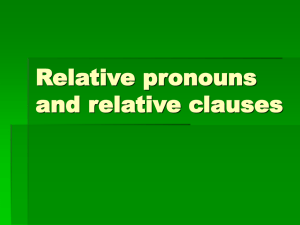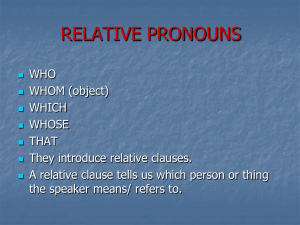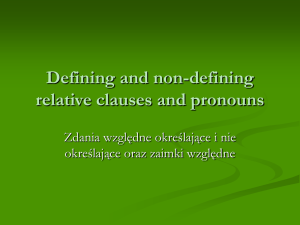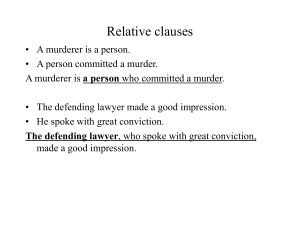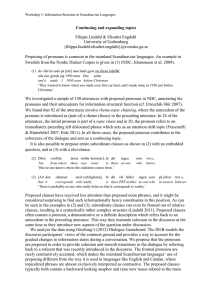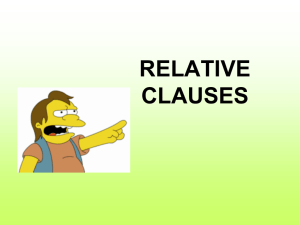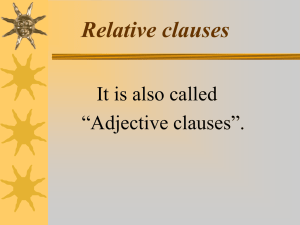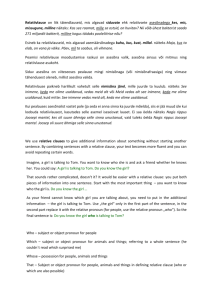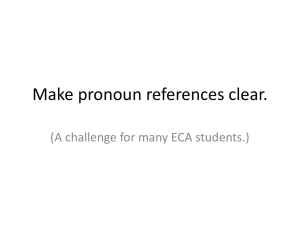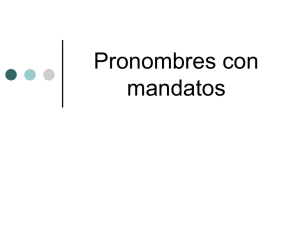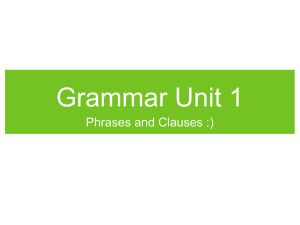RELATIVE PRONOUNS RELATIVE DEFINING CLAUSES
advertisement
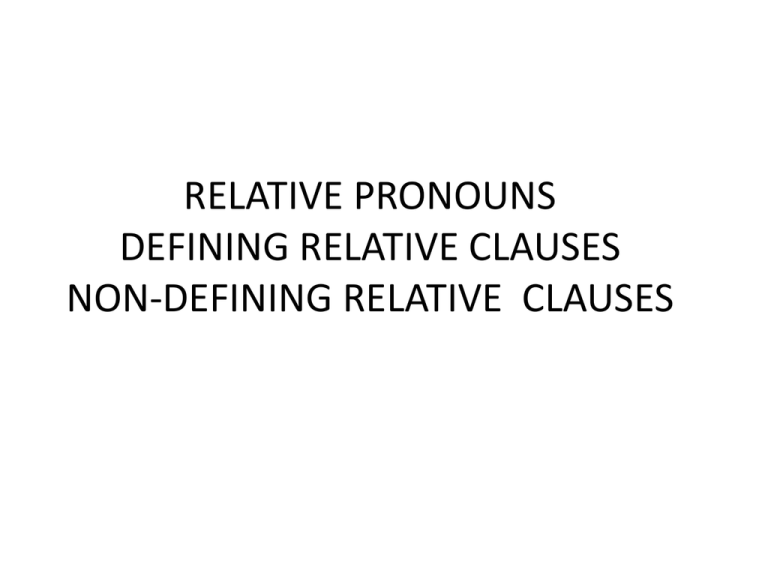
RELATIVE PRONOUNS DEFINING RELATIVE CLAUSES NON-DEFINING RELATIVE CLAUSES • When we want to give extra information about the subject or the object of a sentence we need to add extra clauses. These clauses are often added on, or put inside a sentence and are introduced by relative pronouns. These relative pronouns help to make clear exactly what, where or who the extra information is referring to. RELATIVE PRONOUNS match • • • • • • Who (that) Which (that) When Where Whose Why • • • • • • Possession Place Time Things & Ideas People Reason RELATIVE PRONOUNS key • • • • • • Who (that) Which (that) When Where Whose Why • • • • • • People Things & Ideas Time Place Possession reason Remember • “that” is used instead of who and which when we are speaking or writing informally. • In the past WHOM was often used as the object of a relative clause, but today WHO is more normally used. Which/who/that/where clauses The relative pronouns are used in place of he, she, it or they to join two sentences together: 1) Subject relative clauses: • They were three friends. They often talked about setting up a business. • They were three friends who/that often talked about setting up a business. 2) Object relative clauses: • They approached a number of venture capitalists. They thought they would be interested. • They approached a number of venture capitalists who/that they thought would be interested. 3) Relative clauses with where: • The company bought a bottle plant in the UK. They could manufacture the drinks there. • The company bought a bottle plant in the UK where they could manufacture the drinks. Join sentences using a relative pronoun: • That’s the product. I told you about it. ……………………………………………………………….. • We visited the city. I was born there. ……………………………………………………………….. • I don’t like that man. He works in the marketing department. ……………………………………………………………….. Join sentences using a relative pronoun: KEY • That’s the product which I told you about it. • We visited the city where I was born there. • I don’t like that man who works in the marketing department. Complete with a relative pronoun • The man……..is waiting outside says he has an appointment. • The women……job you took has left her new job and wants to come back here. • The file …..I left on your desk has disappeared • The reason ….. I can’t come is because I’m working that day. key • The man who is waiting outside says he has an appointment. • The women whose job you took over has left her other job and wants to come back here. (=of who) • The file which I left on your desk has disappeared. • The reason why I can’t come is because I’m working that day. Defining relative clauses non – defining relative clauses ? • The extra information which is introduced by the relative pronoun is necessary to the meaning of the sentence . • The extra information is not necessary and can simply give extra, non essential information. Defining relative clauses non – defining relative clauses • The extra information which is introduced by the relative pronoun is necessary to the meaning of the sentence . • The extra information is not necessary and can simply give extra, non essential information. • Defining • Non-defining Defining relative clauses • The defining relative clause identifies and defines the thing/place/person/reason or time talked about. • It is necessary for the meaning: - Example: He’s the man (who that) I met on the plane. • Commas are not used • You can omit (who) when the verbs in the main clause and the relative clause have a different subject. • “that” (instead of which) can only be used for people and things in defining relative clauses. (NOT nondefining) When can you omit (leave out) the pronoun? • When the relative pronoun (who/which/that) is the object of the relative clause and is followed by a noun or a pronoun, then it can be omitted. Example: The woman (who) you saw yesterday has just been promoted. (different subject) • But if the pronoun is the subject of the relative pronoun and so followed by a verb, we must keep it. Example: The technician who came to fix the computer said we needed a new one. (same subject) You can omit the relative pronoun when the verbs in the main clause and in the relative clause have a different subject. example • Example: He’s the man (who/that) I met on the plane. • You can omit who. • The subject of met is I, (not he) so it’s not necessary to put who. (=two different subjects) Other examples: Defining • The summer is the time when we sell more of our products • The weather is (the reason) why I decided to come home early. • This is the street where I was born. • That’s the boy whose father plays for Real Madrid. • It’s a book which tells you how to do marketing Complete the sentences with a relative pronoun: 1. An environmentally-friendly product is a product-----will not harm the environment when you see it. 2. It was in 2005……the Kyoto Agreement on global warming came into force. 3. Glass…..has been recycled can be used again. 4. Deforestation happens in an area ……..all the trees have been cut down. 5. Rain……is polluted with chemicals from factories is called acid rain. 6. A farmer ……farm is organic does not use harmful chemicals to grow food. 7. The greenhouse effect is something …….happens when the sun’s heat is trapped close to the Earth by pollution. 8. An ecologist is a scientist ……studies the environment. 1. An environmentally-friendly product is a product which/that will not harm the environment when you see it. 2. It was in 2005 when the Kyoto Agreement on global warming came into force. 3. Glass which/that has been recycled can be used again. 4. Deforestation happens in an area where all the trees have been cut down. 5. Rain which/that is polluted with chemicals from factories is called acid rain. 6. A farmer whose farm is organic does not use harmful chemicals to grow food. 7. The greenhouse effect is something which/that happens when the sun’s heat is trapped close to the Earth by pollution. 8. An ecologist is a scientist who studies the environment. Add a relative pronoun where it is necessary only. 1. Greenfield sites are places nothing has ever been built. 2. Deforestation is a problem affects the whole world. 3. The bottles we recycled were made of brown glass 4. The green belt is an area of land around a city building is not allowed. 5. The ecologist we saw on television was worried about acid rain. 6. I always buy milk has been organically produced. 7. The man factory was polluting the river was fined over £100,000. Add a relative pronoun where it is necessary only. (KEY) 1. Greenfield sites are places where nothing has ever been built. 2. Deforestation is a problem which/that affects the whole world. 3. The bottles we recycled were made of brown glass 4. The green belt is an area of land around a city where building is not allowed. 5. The ecologist we saw on television was worried about acid rain. 6. I always buy milk which/that has been organically produced. 7. The man whose factory was polluting the river was fined over £100,000. NON-defining relative clauses • The relative pronoun can’t be omitted • In these sentences you can’t use that instead of who/which • The clause is written inside commas: • Example: The regional sales manager, who is a close friend of mine, has just been given a salary rise of 20%. • The information inside commas can be removed without the sentence losing its meaning. (the sentence makes sense without it) Examples of non-defining relative clauses: • Her husband, who/whom I met for the first time last night, works for IBM. • The report on the French subsidiary, which I left on your desk, needs to be rewritten. • This part of the factory, where we make components for conveyor belts, is the oldest part of the plant. • Last week I visited my aunt, who’s nearly 90 years old.
